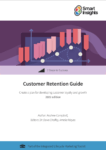Why and how to use hurdle rates to set goals for your digital marketing
 The concept of hurdle rates seems to be quite widely used within finance and investment circles, but I rarely hear it discussed in blogs about measuring and improving digital marketing. Perhaps that's because they're most useful when related to customer retention, or the 'Engage' part of the Smart Insights RACE Planning framework.
The concept of hurdle rates seems to be quite widely used within finance and investment circles, but I rarely hear it discussed in blogs about measuring and improving digital marketing. Perhaps that's because they're most useful when related to customer retention, or the 'Engage' part of the Smart Insights RACE Planning framework.
It's surprising since they offer an excellent way to set goals and track performance against them when you are looking at your effectiveness in communicating with an audience. You can use them to review email marketing, ECRM, customer engagement with social media or repeat purchases. Here's a brief introduction to hurdle rates and some ideas on where you can apply them.
Hurdle rate definition
The hurdle rate for engagement is simply the percentage of customers who perform an activity, they have jumped over the hurdle target you set.
"The proportion of customers that fall within a particular level of activity or engagement with a brand typically within a time period. This is usually expressed as a target percentage and the number who have achieved it".
For example, the percentage of members of an email list that click on the email within a 90 day period, or the number of customers that have made a second purchase.
The value of hurdle rate
Hurdle rates enable you to assess how many of your audience are engaged with your marketing activities so are useful for benchmarking. You can then set targets to use communications to encourage more customers to "jump the hurdle" or engage with you.
Hurdle rate examples
Here are some examples I've used in different areas of digital marketing:
Email marketing - the level of emotionally unsubscribed - the % who never open or never click in a 6 month period - see this analysis.
- Email marketing - the level of active subscribers - the reverse - the % of visitors that have clicked within a 6 month period.
- Social media - likewise - the % of active followers - if you have a Facebook page, Facebook will tell you the proportion of monthly active users. Similarly you could calculate average clickthrough rates across a month in Twitter to see how many of your audience responded. I'm not sure of a simple way to do this. Any ideas?
- Banking - The % of active online account holders - 90 day active is a standard I believe - the % of online customers who log in at least once in that period. You can also set goals for different activities like checking a balance, using online payment services, etc.
- Intranet or communities - the same principle can be applied to how many log-in to a subscription site and the activities they perform. How many bloggers leave comments for example.
- Retail - the example below shows how hurdle rates can be used for Recency, Frequency and Monetary value
Recommended link: Hurdle rate definition in retail - Jim Novo's post about hurdle rates from 2000 which introduced me to the concept of hurdle rates.
Download resource – Customer retention guide
This guide for Expert members explains how to create a customer retention plan to improve customer engagement and value.
Access the Customer retention planning guide






